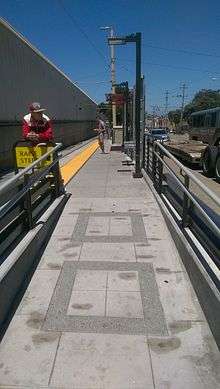Balboa Park station
|
Rapid transit (BART) Light rail (Muni) | |||||||||||||||||||||||||||||||||||||||||||||||
 The concourse of the Balboa Park Station | |||||||||||||||||||||||||||||||||||||||||||||||
| Location |
401 Geneva Avenue San Francisco, CA 94112 | ||||||||||||||||||||||||||||||||||||||||||||||
| Line(s) |
BART | ||||||||||||||||||||||||||||||||||||||||||||||
| Platforms |
1 island platform (BART) 2 tram stop (MUNI) | ||||||||||||||||||||||||||||||||||||||||||||||
| Tracks | 2 (BART), 2 (MUNI) | ||||||||||||||||||||||||||||||||||||||||||||||
| Connections |
8 Bayshore | ||||||||||||||||||||||||||||||||||||||||||||||
| Construction | |||||||||||||||||||||||||||||||||||||||||||||||
| Bicycle facilities | 12 lockers | ||||||||||||||||||||||||||||||||||||||||||||||
| Disabled access | Yes | ||||||||||||||||||||||||||||||||||||||||||||||
| History | |||||||||||||||||||||||||||||||||||||||||||||||
| Opened | November 5, 1973 | ||||||||||||||||||||||||||||||||||||||||||||||
| Traffic | |||||||||||||||||||||||||||||||||||||||||||||||
| Passengers (FY 2013) |
12.123 exits/day[1] | ||||||||||||||||||||||||||||||||||||||||||||||
| Services | |||||||||||||||||||||||||||||||||||||||||||||||
| |||||||||||||||||||||||||||||||||||||||||||||||
Balboa Park is a Bay Area Rapid Transit and Muni Metro station complex located south of Balboa Park in southern San Francisco, California. Along with the four BART lines that pass through the city, two Muni Metro lines terminate here, with another Muni Metro line terminating nearby on the opposite corner.
Interstate 280 runs along the west side of the station, and City College of San Francisco is to the north. The station is popular with passengers who kiss and ride, due to its proximity to Interstate 280, a major commuter route into San Francisco. The station is the southernmost in the BART system that passengers can access using an SF Muni FastPass (which is valid for travel only within San Francisco); the next southbound stop, Daly City Station, is just outside San Francisco, across the San Mateo County border in suburban Daly City.
Balboa Park serves as an official transfer station in the BART system. Although all four BART lines that pass through the station currently continue southward to Daly City, the Balboa Park Station design offers southbound passengers transfers between trains without having to change platforms (the Daly City Station has an island platform and a side platform; southbound lines terminating at Daly City use the former, while those trains continuing on to Colma primarily use the latter). The Balboa Park Station also serves as a major intermodal hub by its multiple local transit connections.
Service at this station began on November 5, 1973.[2]
Balboa Park has been a transfer station ever since service to Colma was extended in 1996.
Station layout
| Ground | Street level | Exit/Entrance to Geneva Ave |
| Mezzanine/ Muni Metro platform |
Mezzanine | One-way faregates, ticket machines, station agent |
| Inbound Muni trains | ← ← | |
| Lower level BART platform | Southbound/Westbound | ← Pittsburg/Bay Point–SFO/Millbrae toward SFO (weekdays), Millbrae (weekends) (Daly City) ← Dublin/Pleasanton–Daly City toward Daly City (Terminus) ← Richmond–Daly City/Millbrae toward Millbrae (weekdays), Daly City (Saturdays) (Daly City) ← Fremont–Daly City toward Daly City (Terminus) |
| Northbound/Eastbound | → Pittsburg/Bay Point–SFO/Millbrae toward Pittsburg / Bay Point (Glen Park) → → Dublin/Pleasanton–Daly City toward Dublin / Pleasanton (Glen Park) → → Richmond–Daly City/Millbrae toward Richmond (Glen Park) → → Fremont–Daly City toward Fremont (Glen Park) → | |

The station consists of two main BART tracks and a single island platform. Unlike most other BART stations, which are either completely underground with artificial lighting, or elevated and open to natural daylight, Balboa Park Station has a trench-like design of uncovered, below-grade boarding platforms with a centrally located, at-grade entrance area covering its midsection, such that a significant amount of sunlight can penetrate the uncovered platform areas at each end of the station. The midsection at-grade level spans the platform area using a series of open arches, and most of the interior walls are finished with rough-textured concrete. The original architects of the station were Corlett & Spackman and Ernest Born.[3] Born also designed the decorative station graphics.
In 2011, a new entrance was opened on the north side of the station to facilitate access to San Francisco City College. The new entrance replaces cumbersome pedestrian routes along steep hills, back alleys, and Muni train tracks with a tight clearance against a wall, all to use the original south side entrance. The entrance is a rampway from Ocean Avenue however there is no station agent at this end but an intercom and sliding gate was installed for contacting him or her.
A Muni Metro rail yard, the Curtis E. Green Light Rail Center, takes up most of the rest of the block, bound by Interstate 280, and Ocean, San Jose, and Geneva Avenues. Muni Metro J Church and K Ingleside trains stop outside between the BART concourse and the rail yard near the corner of San Jose and Geneva Avenues. Then, rather than proceeding to sidings or reversing back like in other terminus stations, the trains circle the rest of the complex. On the other hand, M Ocean View trains stop near the opposite corner of San Jose and Geneva, looping around a building of the older Cameron Beach Yard.
See also
References
- ↑ "BART Fiscal Year Weekday Average Exits". Bay Area Rapid Transit (BART). Archived from the original on 2013-09-22. Retrieved 13 Nov 2013.
- ↑ Bay Area Rapid Transit (2005-06-30). "BART Chronolgy" (PDF). Archived from the original (PDF) on 2013-10-13.
- ↑ "Two BART Stations". Architectural Record, November 1974
External links
Coordinates: 37°43′18″N 122°26′51″W / 37.721629°N 122.447519°W
